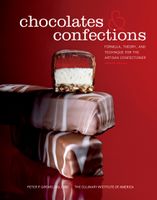Advertisement
Appears in
By Peter Greweling and Culinary Institute of America
Published 2007
Fats in fudge formulas, which may come from milk or cream, added butter, chocolate, or other flavoring ingredients such as nut pastes, contribute to fudge’s short texture, rich mouthfeel, ease of handling, and—if butter or cocoa butter is used—its flavor. Lower-cost, lesser-quality fudge may contain other hard fats that do not contribute flavor but are added purely to affect texture. Because the noncrystalline portion of fudge is a fat-in-water emulsion, excessive fat content leads to an oily appearance and mouthfeel due to separation. Most often the fat separates as the sugar begins to crystallize during agitation. Insufficient fat produces fudge that lacks richness and does not exhibit a good melting characteristic in the mouth.



